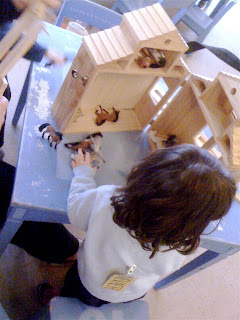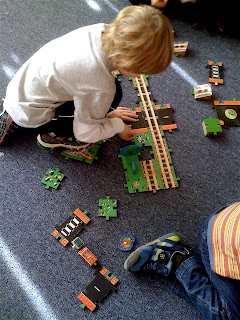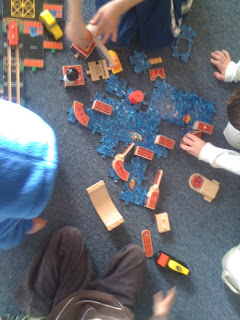On Monday this week my friend and former Woodland Park parent Jean dropped by the school with a load of toys her boys had outgrown. It was quite a stash of cool "new" stuff for us to finish using.
This picture doesn't even include all of it. Everything is a toy we'll put to good use, although, as always, it makes me wish for that warehouse to store it. We broke out the barn and pony set (with 12 different breeds of ponies!) for the Pre-3 class on Tuesday morning.
But we saved the rest of the toys for the Pre-K group (9 boys and no girls this year) to break in on Tuesday afternoon. This is often the tactic I use with new or especially exciting activities: introduce them to the smaller group of older children first by way of letting a little air out of the "competition" for turns when the larger group is together. My initial instinct was to spread the toys around the class room, give the boys a chance to explore them, then come back together to make charts ranking them according to various criteria. But since we've been having issues with some of the boys' dramatic action play being too intense for some of the younger kids, I thought instead to try using them to work on developing the habit of thinking about our friends and how they might feel, following up on the work we did last week surrounding our celebration of MLK.
The boys finished lunch to find all the new toys arranged as if on a shelf in a toy store, the caveat being that I'd placed a tape line on the floor across which no part of their bodies was to cross, not even a hand reaching out to touch something. This is a convention we establish early in the Pre-K school year because we sometimes work with sharp knives, flame, hot plates, and other potentially "dangerous" items that I don't want them to handle on their own. The kids learn to stand back and examine what is behind the line with their eyes first, assessing the risk. If there is an unknown liquid there, they might say, "That could be poison." On the other hand, most of the time they say something like, "Those are just stuffed animals, Teacher Tom, they're not dangerous." But they still know by now not to cross the line. It's a good exercise in self control.
This was obviously just a collection of toys and, man, you should have seen how they crowded right up to the line to examine them. "What's that fire truck, Teacher Tom?" "I see a digger. It's a front loader!" "There's a space ship!" "Lincoln Logs! I have those at home."
"Are we going to play with them?"
When the boys had settled down, eyes still surveying the toys, I told them about Sam and Ian, how they had once been children at our school, how they'd grown up, and that they thought we'd like playing with some of their old toys. I said, "They were thinking about what you might like to play with."
"Are we going to play with them?"
"First we're going to talk about them." It's sometimes a challenge to "just talk" in a group of nine 4-year-old boys, but I had their attention -- or rather the toys did. I then began going through them one at a time, demonstrating them. They named the toys, then I said, "I want you to think about our other friends in class, not your friends here in Pre-K, but the younger kids. Who do you think would really like to play with this?"
I was prepared for them to take a lazy route and just keep naming the same child over and over. I was going to say, they needed to think of a different friend, but I didn't need to go there. As we methodically went through the toys one-by-one, the boys really seemed to be considering who among their classmates would get a special kick out of the various toys. They thought Violet, for instance, would like the pony play set, a natural given that she likes to wear her cowgirl boots to class most days. And they were pretty sure that Sylvia would like the dinosaurs, creatures for which she's often expressed an affinity.
I complimented them each time for their thoughtfulness, emphasizing that I liked the way they were really thinking about how their friends might feel. "I think you're right, Connor will like playing with that. That's very thoughtful of you to think of him."
The only problem with this exercise was that it was quickly eating up way more time than I'd anticipated. By way of speeding things up, I tried skipping a few of the smaller toys, but by then they wouldn't have it, so clock be damned we went through the entire collection.
"Now," I said, "We get to pick one of these toys to play with together."
At this, there was a lot of shouting and advocating and pointing. "I want to play with the digger!" "No, the tent!" "The space station!"
Once we got back into taking turns by raising hands, we started once more wading through the toys. "We need to find a toy that we can all play with together, right?"
They all seemed to agree with that, although Dennis piped up, "Or we could take turns."
"That's true. We could pick a toy we can all play with together or we can pick and toy and take turns. For instance, what about the fire truck. How could we all play with the fire truck?"
"Take turns!"
"Who gets the first turn?"
Nine voices called out, "Me!"
"Hmm, you can't all be first. How do we decide who goes first?"
"Me!" "Me!" "Me!" Then Dennis said, "We could vote." I didn't do a very good job with this, but we kind of fumbled our way through to the idea that everyone would probably just vote for themselves and "What's a bigger number, one, one, one or one?" "They're all the same!" Well that won't work.
My goal was to get them to move away from "me" and onto "we."
"So it seems like we need to pick a toy that we can all play with at the same time." I then started through a process of elimination, going through the toys one at a time, asking, "Can we all play with this one together?"
Now, in all honesty, I had my eye on a few of the more likely candidates: the tent, the faux Lincoln Logs, and the large Melissa & Doug brand Puzzle World sets. As we came to them, I mentioned their features as toys with which we could all play together:
"We could all work together setting up the tent."
"The Lincoln Logs have lots of pieces."
"This Puzzle World set has 61 pieces and this one has 77. That's more than 100 pieces."
Most were easy, being eliminated more on the boys' collective estimate of its lower play value, although some were more challenging to take off the table, like the fire truck. With some steering on my part, however, we finally narrowed it down to the 3 toys with the most to offer to large group play and the space station. This was our biggest challenge. There were only 3 space vehicles and 9 boys. They were good about insisting that they could take turns, but repeatedly stopped themselves when I asked them to consider who would get the first turn. We went around and around for quite some time, until finally Charlie L. said, "He can have the first turn and I can have the second turn."
That was huge, but it only lasted a moment before other boys began to say they ought to have the second turn. Finally, and without reaching consensus, we removed the space station from the mix, with my promise that we would figure out a way to play with it next time.
It was down to 3 toys from the two dozen or so we'd started with. We'd now spent at least thrice the time I'd planned for this activity and we hadn't even gotten around to playing with a toy. From here we went with Dennis' plan from earlier and voted. The Puzzle World sets edged out the tent, aided, I think, in large measure by Ariya's repeated and excited declaration, "That one has 61 pieces and that one has 77 pieces!"
Ultimately, that was the deciding factor, not glamor, not action, not colors or TV commercials. We chose the toy with which we could play together based on it having enough pieces for everyone.
By the time we were done, we'd consumed nearly 1.5 hours of a 2.5 hour class. Nine 4-year-old boys sitting on a blue rug doing the hard work of thinking about the other people.
(Note: In the interest of full disclosure, the dialog in this post is recreated from memory with many of the side-tracks and diversions left out, but it more or less reflects the process as I experienced it.)












4 comments:
Oh - I love all the toys! Hey - what is the disclosure in the end all about?
@Deborah . . . I just want to be clear that I'm not directly quoting as much as "estimating" the quotes in this post. I usually try very hard to honor children's words by quoting them exactly as they're spoken. In this case, I'm sort of cobbling together the conversation as best I can. Also, when I read back through it, I felt like the post left the impression that this conversation somehow followed a straight line from point A to point B. It didn't. We rambled all over the place between the two points! =)
I think mentioning the length of the discussion pretty much covers the rambling bits. And how great that you gave them the time. They sound like, despite the ramblings, they were very focused and getting so much out of it. And the toys will be there tomorrow and the next day and the next. The discussion, on the other hand, might never have taken place without the patience of a teacher wiling to lead them through it.
THIS. IS. EXCELLENT. As a Montessori assistant, I've often wondered about the best way to get the older group to leave the simple activities (for a 6 yr. old) on the shelves for the new children (2.5-3 yr. olds) who will be challenged by them. This has been exceedingly difficult to resolve because often the only way seems to be to impose my will and tell them they may not use some of the toys (which generally only come out at the beginning of the year while the children are getting acclimated and getting the preliminary lessons of the classroom). I really like the no touch line... adding that to the bag of tricks!
Post a Comment